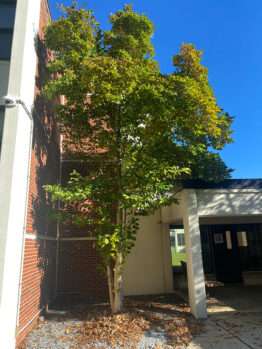Star Magnolia
Researched by Ally Reagle
 Species: Magnolia stellata
Species: Magnolia stellataCommon name: Star Magnolia
Family: Magnoliaceae (Magnolia Family)
Clade: Angiosperms (flowering seed plants)
Coordinates: 39.70726549 -75.11694579
A tag using this number is placed near the tree.
The Magnolia stellata, more commonly called the star magnolia, is endemic to the Tokai region of central Japan. This tree was introduced to the United States in the 1860s and features eye-catching and fragrant blooms in the spring. Since then, horticulturists have selectively bred varieties that alter the flower shape, color, and bloom time. These varieties, or cultivars, typically have their epithet, meaning you may hear them referred to by a different common name to distinguish between the types. For example, the waterlily magnolia blooms about two weeks later than the original star magnolia, but it is a variation of the star magnolia.
The star magnolia can be grown as a large shrub or pruned into a small tree. A healthy star magnolia will grow 15-20 feet tall with a canopy between 10-15 feet, making them ideal ornamental trees for front yards and gardens. The main trunk has a silvery/gray hue, whereas the lower twigs protruding out of the side of the trunk are more of a chestnut brown color.
In autumn, the leaves will turn yellowish bronze before dying off and falling to the ground. The tree has wooly, fuzzy buds that stay all winter. The fur coating protects these soon-to-be flowers, which display during a three-week period early each spring. Each flower typically has 12-18 petals, but some cultivars can have up to 30. The blooms are soon replaced by dark green leaves in the summer. Later in the summer, the plant produces bright pink aggregated fruit capsules that burst open to reveal orange seeds. Many people plant Star magnolias because of how early this tree blooms; it can signify that spring is coming. However, this also makes them very susceptible to frost damage. Read More
Campus Species Map
Researcher’s Biography
 Ally Reagle
Ally Reagle
Ally Reagle earned a Bachelor of Science degree in Biological Sciences in 2023.
Suggested Citation:
Reagle, Alexandra. (2022, Dec). Star Magnolia. Rowan University Arboretum. https://arboretum.rowan.edu/trees/star-magnolia/
Questions to Explore
- Can a Star magnolia tree be treated for magnolia scales? If so, what is the process like?
- What techniques are used to create different cultivars?
- How do beetles benefit from the pollination process? What do they use pollen for?
- Are magnolia stellatas’ considered invasive in New Jersey since they are not native?
References
Beaulieu, D. (2022, July 18). How to Grow and Care for Star Magnolia. The Spruce. | Link
Larson, J. L. (2021, February). Magnolia scale. Entomology at the University of Kentucky. | Link
Magnolia scale. (n.d.). Chicago Botanical Garden. Retrieved December 11, 2022 | Link
Magnolia scale. (2022, September 2). The Morton Arboretum. | Link
Magnolia stellata. (n.d.). Jersey-Friendly Yards. | Link
Magnolia stellata ‘Royal Star’. (n.d.). Missouri Botanical Garden. | Link
Magnolia stellata ‘Waterlily’. (n.d.). Missouri Botanical Garden. | Link
Magnolia stellata ‘Waterlily’. (n.d.). Oregon State University. | Link
Mahr, Susan. (n.d.). Star Magnolia, Magnolia stellata. Wisconsin Horticulture. | Link
Overview of angiosperm phylogeny. (2021, September 14). Digital Atlas of Ancient Life. | Link
Pankau, Ryan. (2018, May 05). Magnolia Pollination. Illinois Extension. | Link
Setsuko, Tamaki, I., Ishida, K., & Tomaru, N. (2008). Relationships between flowering phenology and female reproductive success in the Japanese tree species Magnolia stellata. Botany, 86(3), 248–258. | Link
Star Magnolia. (n.d.). Bernheim Arboretum and Research Forest. | Link
Star Magnolia. (n.d.). Yale University-Yale Nature Walk. | Link
Rowan University Resources
You may need to log into the Rowan University Library website.
Effects of pollen shortage and self-pollination on seed production of endangered tree, Magnolia stellata | Link
Reduced seed production, inbreeding, and pollen shortage in a small population of a threatened tree, Magnolia stellata | Link
Relationships between flowering phenology and female reproductive success in the Japanese tree species Magnolia Stellata | Link




















